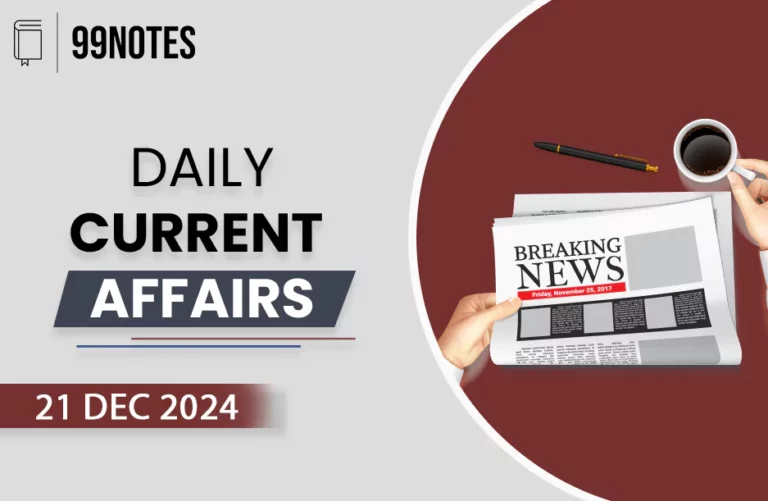16 August 2023 : Daily Current Affairs
Daily Current Affairs
- Daily Current Affairs
- 1. Karnataka to release 10 TMC Cauvery water to Tamil Nadu
- 2. 275 bird species counted during survey at Corbett Tiger Reserve
- 3. Kerala likely to face drought due to deficit monsoon
- 4. Karnataka CM warns elements disturbing communal harmony
- 5. Reimagining the role of state universities in science education.
- 6. AYUSH sector set to clock $24 bn this year.
- 7. Livelihood opportunities and Drone Training for Women.
- 8. Jan Dhan yojana: Steady growth in new accounts
- 9. India and Russia’s Moon missions
- For Enquiry
16-August-2023
Daily Current Affairs For UPSC ,Daily Current affairs of The hIndu and Indian Express.
1. Karnataka to release 10 TMC Cauvery water to Tamil Nadu
Topic: GS2 – Interstate river disputes.
Context:
- Karnataka’s Deputy Chief Minister D.K. Shivakumar announced the release of 10 TMC of Cauvery river water to Tamil Nadu.
- Tamil Nadu had moved the Supreme Court to direct Karnataka to release 24,000 cusecs of water for the remaining month due to crop demands.
More about Kaveri River water dispute:
- Interstate Conflict: Involves Karnataka and Tamil Nadu, with Puducherry and Kerala as minor stakeholders.
- Origins: Roots in colonial-era agreements for water sharing.
- Post-Independence Tensions: Population growth and irrigation demands intensified the dispute.
- Tribunals: Cauvery Water Disputes Tribunal (CWD) established in 1990 to mediate.
- Allocation: CWD awarded Karnataka 270 TMC, Tamil Nadu 419 TMC, Kerala 30 TMC, Puducherry 7 TMC.
- Contentions: Both states faced non-compliance issues with water releases.
- Political and Social Impact: Protests, political tensions, and violence due to farmers’ dependence on Cauvery water.
- Challenges to reach the solution: Complex issue with historical, economic, and political dimensions.
2. 275 bird species counted during survey at Corbett Tiger Reserve
Topic: GS3 – environment and ecology.
Critical Endangered Species:
- Survey documented two critically endangered bird species: white-rumped vulture and red-headed vulture.
- Both species listed as critically endangered by the International Union for Conservation of Nature (IUCN).
Endangered Species:
- Endangered species documented include Pallas’s fish-eagle and Egyptian vulture.
Vulnerable Species:
- Vulnerable bird species counted: great hornbill, great slaty woodpecker, grey-crowned prinia, river tern.
Near-Threatened Species:
- Survey found 10 near-threatened species, including river lapwing, red-breasted parakeet, oriental darter, and more.
Importance: IUCN status of the mentioned species can be important from prelims perspective.
3. Kerala likely to face drought due to deficit monsoon
Topic: GS1 – geography
Context:
- Southwest monsoon rainfall between June and August deficient by 44% in the state of Kerala.
- Drought-like conditions looming large in Kerala and many parts of India due to low monsoon.
Impact of low monsoon on Indian economy:
- Agriculture: Reduced water availability affects crop yield, leading to lower agricultural output and income for farmers.
- Food Prices: Decreased crop production leads to scarcity, causing food prices to rise, affecting inflation and affordability.
- Rural Income: Lower farm earnings impact rural livelihoods, leading to reduced purchasing power and economic activity.
- Hydroelectric Power: Reduced water levels in reservoirs affect hydroelectric power generation, impacting energy supply and pricing.
- Water Scarcity: Drought conditions stress water resources, affecting domestic, industrial, and agricultural needs.
- Trade Balance: Lower agricultural exports due to decreased output affect trade balance and foreign exchange earnings.
- GDP Growth: Agricultural sector contraction impacts overall GDP growth, hindering economic recovery and development.
- Employment: Agriculture-related employment opportunities decline, leading to potential rural unemployment.
4. Karnataka CM warns elements disturbing communal harmony
Topic: GS1 – Indian society
Context:
- Karnataka CM Siddaramaiah warns against disturbing communal and social harmony on Independence Day.
Factors disturbing communal harmony in India in recent times:
- Religious Polarization: Politicization of religion and religious identity for electoral gains.
- Hate Speech and Incitement: Use of inflammatory language and speeches that fuel communal tensions.
- Social Media Misuse: Spread of fake news, misinformation, and hate content through social media platforms.
- Cultural and Historical Disputes: Controversies over cultural practices and historical events leading to tensions.
- Political Manipulation: Utilization of communal sentiments for political agendas.
- Religious Conversions: Tensions arising from religious conversions and allegations of forced conversions.
- Regional and Linguistic Divides: Conflicts based on regional and linguistic identities.
- Economic Disparities: Socioeconomic disparities leading to communal tensions in resource-sharing.
- Caste Conflicts: Overlapping caste and communal issues triggering unrest.
5. Reimagining the role of state universities in science education.
Topic: GS3 – education sector
National Education Policy 2020 and Skill-Based Education:
- NEP 2020 aims to promote skill-based education and practical learning.
- Focus on skill development is particularly relevant to higher science education in India.
Current Scenario of Science Education:
- Many students pursue BSc and subsequent courses after higher secondary education.
- India produces over 25 lakh STEM graduates annually.
- Large segment of science education includes BSc-level and subsequent courses.
- Graduates can continue with higher studies or enter the workforce.
Challenges in Science Education:
- Outdated curricula and syllabi.
- Insufficient practical training and laboratory facilities.
- Limited opportunities for internships.
Need for Re-Envisioning State Universities:
- State universities face resource constraints and outdated curricula.
- Reimagining them as hubs for skill-based science education is suggested.
- State universities and colleges play a significant role in higher science education.
- They have largest share of enrolments across universities in India.
Need for Skill-Based Education Approach:
- Curricula can focus on industry-relevant skills and certifications.
- Collaboration with industries for seminars, apprenticeships, job fairs, and funding support.
- Emphasis on employability in the scientific sector.
Conclusion:
- Skill-based education and practical training in State-affiliated universities can address challenges in science education, enhance employability, and align with India’s goals of fostering skilled personnel in the scientific sector.
6. AYUSH sector set to clock $24 bn this year.
Context:
THE AYUSH — Ayurveda, Yoga and Naturopathy, Unani, Siddha and Homeopathy—sector has seen exponential growth in production of medicines and supplements from just over $3billion in 2014 to $18billion in 2020, and is anticipated to clock $24 billion in 2023, according to Union AYUSH Secretary Rajesh Kotecha.
WHO Global Traditional Medicine Summit
- To be held in Gujarat’s Gandhinagar on August 17-18.
- The summit is being cohosted by the WHO and India, which holds presidency of G20.
- Will set the tone for future activities of the WHO Global Centre for Traditional Medicine, located at Jamnagar in Gujarat.
- Experts from more than 90 countries will attend the event, which will be a platform for all stakeholders — policymakers, academics, researchers, and private sector participants—to share best practices and evidence, data, and innovation on the contribution of traditional medicine to health and sustainable development.
- WHO will present emerging findings from the third global survey on traditional medicine. The complete survey will inform the development of WHO’s updated traditional medicine strategy between 2025 and 2034, as requested by the World Health Assembly in May this year.
Response to AYUSH based health and wellness centres.
- There is a huge response to AYUSH-based health and wellness centres
- At present, 7,000 such centres are operational and data from states (from January to December2022) indicate that 8.42 crore patients have availed of the services.
Steps taken by WHO
- WHO is working with its member-states on standards and benchmarks for different traditional medicine systems and their evidence-based integration in the International Classification of Diseases (ICD).
- The ICD allows countries to count and identify their most pressing health issues, and it does not include, refer to, nor endorse any therapy.
- Around 40% pharmaceutical products today have a natural product basis, and landmark drugs derived from traditional medicines.
7. Livelihood opportunities and Drone Training for Women.
Context
Reaching out to the socially and economically backward classes, Prime Minister Narendra Modi on Tuesday announced two key initiatives—the Vishwakarma Yojana to boost livelihood opportunities for people engaged in traditional skills, and the Lakhpati Didi scheme to ensure an annual income of at least Rs 1 lakh for 2 crore women in villages by providing skill development training.
Features
- With an outlay of Rs 13,000 crore to Rs 15,000 crore, the Vishwakarma Yojana will be launched on Vishwakarma Jayanti (September17).
- On this Vishwakarma Jayanti, govt will give about Rs 13,000- 15,000 crore to the people who live with traditional skills, who work with tools, and with their own hands, mostly belonging to the OBC community. Be it carpenters, goldsmiths, masons, washermen, barbers etc to give new strength to such people
- Drone pilot training would be provided to women self-help groups as part of skill development and also for bringing technology to agriculture sector.
- Training for operating and repairing drones would also be given.
- Government of India will provide drones to thousands of such women self help groups.
- To begin with, the scheme will be launched among 15,000 women self-help groups.
Benefits
- It will revolutionalise India’s agriculture landscape and will give more power to women, which is a key towards growth of our nation.
- It is likely to speedup adoption of drone technology in the field of agriculture and will lead to substantial employment generation and agribusiness opportunities in rural areas.
8. Jan Dhan yojana: Steady growth in new accounts
Context:
Pradhan Mantri Jan Dhan Yojana (PMJDY) bank accounts, with an accumulated Rs 2.03 trillion cash balance, continues to rise steadily nine years after its launch.
Latest Figures
- As many as 35.9 million new PMJDY accounts were opened in FY23 compared with 28.6 million in FY22 and 38.7 million in FY21.
- With nearly 10 million new accounts opened in the first four months of FY24, the cumulative PMJDY accounts stood at 496.3million by end of July.
- In terms of cash deposits, however, the incremental deposits were just around Rs 4,000 crore so far in the current fiscal, taking the total to Rs 2.03trillion as on August2,2023, from Rs1.99 trillion on March 31, 2023.
- In FY23, fresh accretion in PMJDY accounts was a record Rs 50,000 crore.
- Most of the PMJDY accounts are with the public sector banks that have steered the financial inclusion drive.
- The number of PMJDY accounts opened by PSBs rose from 332.62 million in March 2021 to 385.89 million in May 2023, an increase of 16 per cent.
- Regional Rural Banks (RRBs) have a 21 per cent increase in their PMJDY accounts to around 91 million in May 2023 from 71 million in March 2021.
Main features of Jan Dhan Yojana
- The main features of the scheme include one basic savings bank deposit (BSBD) account to every unbanked adult, an overdraft (OD)limit of Rs10,000 and a free RuPay debit card with inbuilt accident insurance cover of upto Rs 2,00,000.
9. India and Russia’s Moon missions
Context:
RUSSIA’S mission to the Moon, Luna-25, is generating interest in India too. This is because the Russian lander is likely to touch down close to the lunar South Pole days before India, beating the latter to the title of the first country to do so. The Russian mission was launched on August 10. It is likely to enter the moon’s orbit by August 16 and attempt tosoft-landbyAugust21or22.India’s mission cannot land before August 23, when it will be lunar dawn at the landing site.
Why is it reaching the Moon earlier?
- Although Luna-25 was launched last week aboard its Soyuz rocket, almost a month after the launch of Chandrayaan-3 on July14, it will cover the 3.84-lakh-km journey within days because The Russian mission was able to follow a more direct trajectory towards the Moon, owing to its lighter payload.
- The lift-off mass for Luna-25 is just 1,750 kg as compared with the 3,900 kg of Chandrayaan-3.
- To make up for the lower fuel reserve available on the LVM3 vehicle that launched India’s mission, a more circuitous route was taken. After launch, the orbit of the space craft was increased in a series of manoeuvres to help it gain velocity.
- The spacecraft was then slingshot towards the Moon, reaching the lunar orbit nearly 22 days after it was launched. Over the next few days, Chandrayaan-3 will reduce its orbit and velocity around the Moon in preparation for the soft landing likely to be attempted on August23.
- Another reason Luna-25 can land before India is because lunar dawn at its landing site is earlier. One lunar day is equal to 14 Earth days. With the pay loads powered by solar panels, landing at the beginning of a lunar day ensures the experiments get the full 14 earth days.
How do the missions differ?
- Apart from being lighter than the Indian mission, Luna-25 does not carry a rover while on the other hand Chandrayaan-3 has a rover capable of moving around 500 metres.
- The Russian lander has eight payloads mainly to study the Moon’s soil composition, dust particles in the polar exosphere, and most importantly, detect surface water while the Indian mission also has scientific instruments to study the lunar soil and water ice. The location near the southern pole was chosen because of the presence of craters that remain in permanent shadow, increasing the likelihood of finding water-ice.
- The lander will carry four experiments onboard. The Radio Anatomy of Moon Bound Hypersensitive ionosphere and Atmosphere (RAMBHA) has a Langmuir probe used to study properties of electrons and ions, such as temperature and density. It will study these properties near the surface of the moon and how they change over time.
- The Chandra’s Surface Thermo physical Experiment (ChaSTE) will study the thermal properties of the lunar surface near the polar region. The Instrument for Lunar Seismic Activity(ILSA) will measure the lunar quakes near the landing site and study the composition of the moon’s crust and mantle.
- There are two scientific experiments on the rover. The LASER Induced Breakdown Spectroscope (LIBS) will determine the chemical and mineral composition of the lunar surface. The Alpha Particle X-ray Spectrometer (APXS) will determine the composition of elements such as Magnesium, Aluminium, Silicon, Potassium, Calcium, Titanium, and Iron in the lunar soil and rocks
- The main difference, however, is that India’s mission is built to last only one lunar day. This is because it does not have a heating mechanism to keep the electronics safe from the extreme cold during the lunar night. The Russian mission will work for a year, meaning it has a heating mechanism as well as a power source other than solar panel.
Is India in the race to land humans on the Moon?
- It was the discovery of water molecules by India’s Chandrayaan-1 in 2008 that has propelled another race to the Moon
- Although India, with its limited resources, has caught up with countries with more advanced space agencies, there is still a long way to go before it can send humans to the Moon.
For Enquiry

16 August 2023 : Daily Current Affairs

14 August 2023 : Daily Quiz

14 August 2023 : PIB

14 August 2023 : The Hindu Editorial Notes PDF

14 August 2023 : Daily Current Affairs

12 August 2023 : Daily Quiz

12 August 2023 : PIB

12 August 2023 : The Hindu Editorial Notes PDF

12 August 2023 : Daily Current Affairs

11 August 2023 : Daily Answer Writing
August Daily Current Affairs 16 August 2023 : Daily Current Affairs Daily Current Affairs
14-August-2023
Daily Current Affairs For UPSC ,Daily Current affairs of The hIndu…
Daily Quiz 14 August 2023 : Daily Quiz 14 August 2023 : Daily Quiz…
August PIB 2023 14 August 2023 : PIB PRESS INFORMATION BUREAU
14-August -2023
Daily Current Affairs For UPSC ,The PIB ( Press Information…
August- The Hindu Editorial 14 August 2023 : The Hindu Editorial Notes PDF The Hindu Editorial
14-August-2023
Daily Current Affairs For UPSC ,The Hindu Editorial Summary
Facebook-f
Twitter
Youtube
1. Pakistan’s…
August Daily Current Affairs 14 August 2023 : Daily Current Affairs Daily Current Affairs
14-August-2023
Daily Current Affairs For UPSC ,Daily Current affairs of The hIndu…
Daily Quiz 12 August 2023 : Daily Quiz 12 August 2023 : Daily Quiz…
August PIB 2023 12 August 2023 : PIB PRESS INFORMATION BUREAU
12-August -2023
Daily Current Affairs For UPSC ,The PIB ( Press Information…
August- The Hindu Editorial 12 August 2023 : The Hindu Editorial Notes PDF The Hindu Editorial
12-August-2023
Daily Current Affairs For UPSC ,The Hindu Editorial Summary
Facebook-f
Twitter
Youtube
1. India…
August Daily Current Affairs 12 August 2023 : Daily Current Affairs Daily Current Affairs
12-August-2023
Daily Current Affairs For UPSC ,Daily Current affairs of The hIndu…
mains answer writing 11 August 2023 : Daily Answer Writing Mains Answer Writing
One of the key components of these exams is the written test, which consists of…




